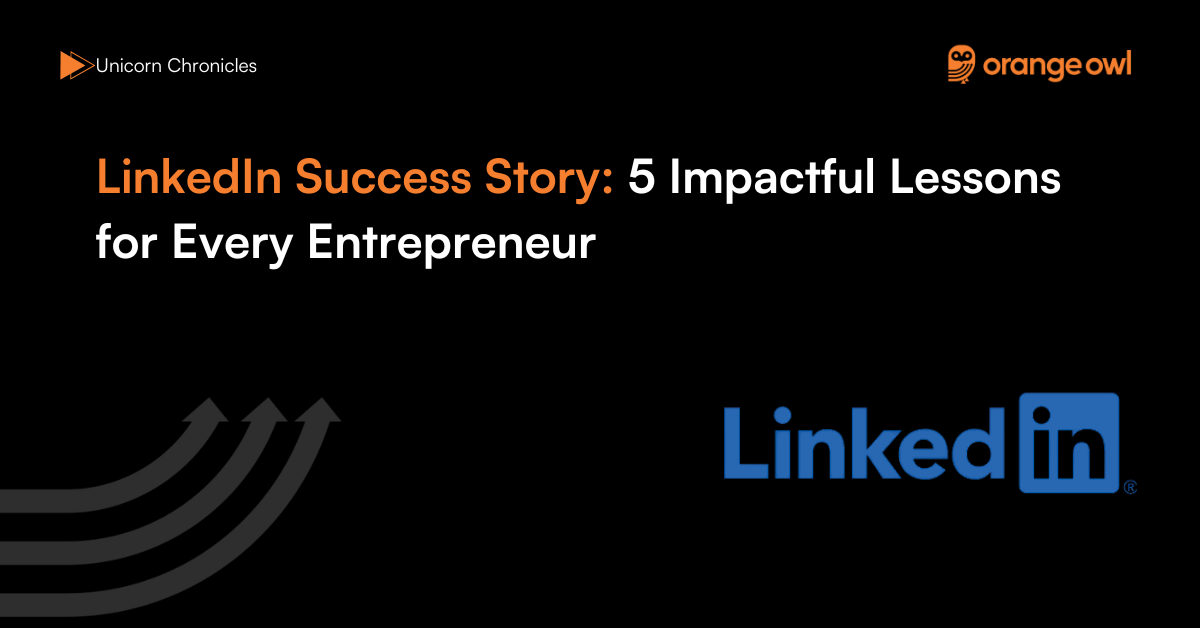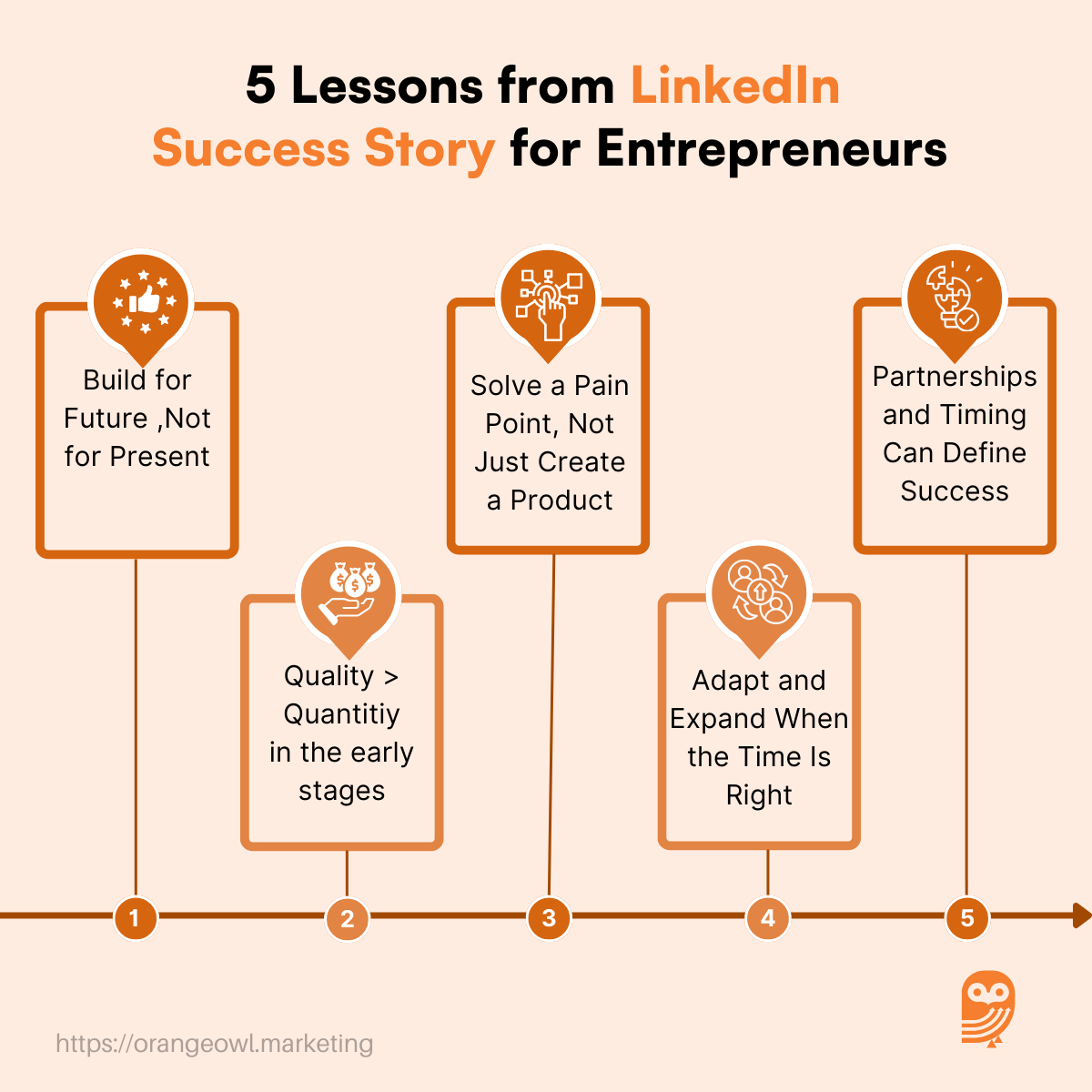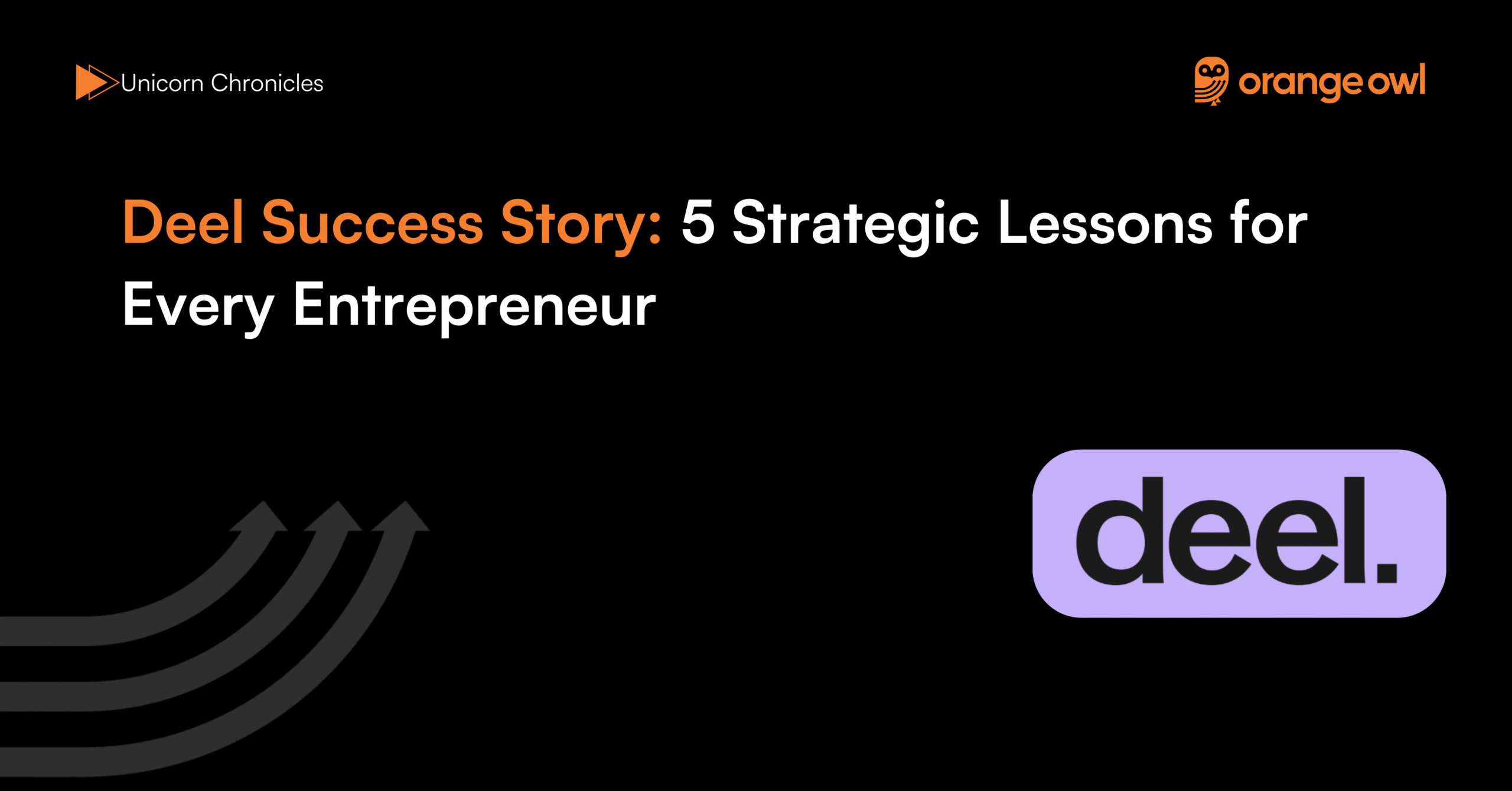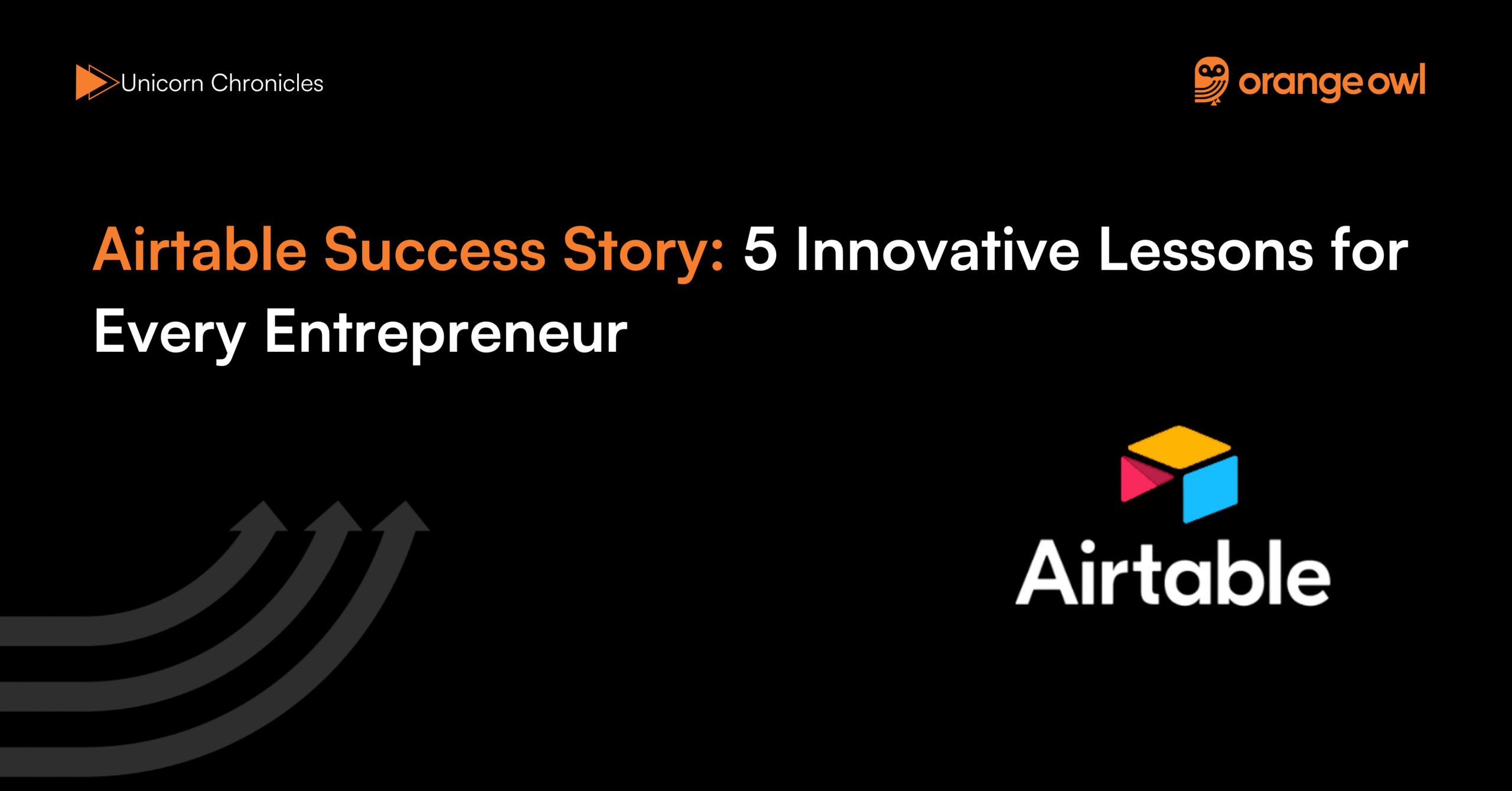LinkedIn Success Story: 5 Impactful Lessons for Every Entrepreneur
Orange Owl
August 22, 2025

Table of Contents
Introduction
In 2002, five visionaries — Reid Hoffman, Allen Blue, Konstantin Guericke, Eric Ly, and Jean-Luc Vaillant — came together with a simple yet bold idea: to create an online platform where professionals could connect, share opportunities, and build their careers. That idea became LinkedIn, officially launched on May 5, 2003.
From just 4,500 members in its first month, LinkedIn has transformed into the world’s largest professional network, boasting over 1 billion users across 200+ countries today. What started as a living room project in Mountain View now sits at the heart of global recruiting, networking, and B2B marketing.
Acquired by Microsoft in 2016 for $26.2 billion, LinkedIn continues to grow as a powerhouse in the digital economy. As of 2025, its current valuation is estimated at around $30 billion, underscoring the platform’s unmatched role in shaping professional lives worldwide.
Origin Story
The idea for LinkedIn took shape in Reid Hoffman’s living room in Mountain View, California, in 2002. At the time, the concept of online networking was still in its infancy. Platforms like Friendster and MySpace were gaining traction for personal connections, but no one had envisioned using the same model to empower professional growth and careers.
Hoffman, who had already built a strong reputation in Silicon Valley, gathered a team of like-minded innovators — Allen Blue, Konstantin Guericke, Eric Ly, and Jean-Luc Vaillant. Together, they identified a glaring gap: while professional success depended heavily on relationships and networks, there was no digital infrastructure to map, manage, or grow these connections.
By May 2003, LinkedIn launched its first version. Growth in the beginning was modest, with only 20 signups on the very first day. Unlike consumer social platforms, where viral loops fueled instant growth, LinkedIn faced a unique challenge: building trust and credibility in the professional world. Convincing people to share their resumes, achievements, and career aspirations online required a higher degree of confidence in the platform.
Despite the slow start, the founders stayed persistent. Their belief was that network-driven opportunity discovery would eventually become a necessity, not a luxury. As Hoffman later reflected, “We weren’t just building a product; we were solving a deep pain point for millions of professionals who needed a better way to connect, collaborate, and grow.”
This vision of creating an online “economic graph” — a digital map of people, jobs, skills, and companies — became the foundation on which LinkedIn would later revolutionise the way the world works.
Business Landscape and Challenges
When LinkedIn launched in 2003, the online networking landscape was crowded yet fragmented. Social media platforms like Friendster, Orkut, and MySpace were gaining traction, but they focused on personal connections, entertainment, and casual interactions. None of them were designed to solve the very specific and serious problem of building professional credibility and fostering career opportunities.
LinkedIn entered this space with a unique proposition: professional networking with real-world career value. Instead of chasing entertainment or virality, the platform emphasised trust, resumes, and professional growth. This positioning gave LinkedIn a niche, but it also posed significant challenges. The idea of putting personal career information online was new, and professionals were initially reluctant to share too much publicly.
Early struggles also included slow user adoption — after the first week, LinkedIn only had 2,500 members, compared to the millions flocking to personal social platforms. Another challenge was monetisation. Unlike ad-driven models used by other social networks, LinkedIn had to figure out how to create revenue streams that aligned with its professional ethos.
Additionally, LinkedIn had to overcome network effects — the value of the platform increased only when a significant number of professionals joined. Convincing people to join before the network had wide adoption was one of the toughest early hurdles.
Despite these challenges, LinkedIn steadily carved out its own category, proving that a professional-first social network could not only survive but thrive in an internet era dominated by casual connections.
Growth Strategy
LinkedIn’s growth was built on a mix of strategic product choices, network effects, and monetisation models that strengthened its professional-first positioning.
One of the earliest strategies was the “address book import” feature, which allowed users to upload their email contacts and instantly connect with colleagues. This simple step created a viral loop — as more professionals joined, the platform’s value increased, fueling organic growth.
The company also focused on profile completeness as a driver of engagement. By encouraging users to add education, work history, and skills, LinkedIn created a digital resume that professionals found valuable even outside the platform. Recruiters quickly recognised this, leading to LinkedIn’s Recruiter product, which became a major revenue driver.
Strategic acquisitions played a big role in scaling. The purchase of Slideshare (2012) and Lynda.com (2015) expanded LinkedIn’s value beyond networking, moving into content sharing and professional learning. This helped LinkedIn transition from just a resume site to a career development ecosystem.
On the monetisation front, LinkedIn balanced subscription plans (Premium, Recruiter Lite) with ads and sponsored content, ensuring multiple revenue streams. By targeting professionals and businesses rather than mass entertainment users, LinkedIn created a more sustainable model than typical social networks.
Finally, partnerships and integrations with Microsoft, Salesforce, and other enterprise players positioned LinkedIn as an indispensable tool in professional workflows. The Microsoft acquisition in 2016 further accelerated this strategy, integrating LinkedIn with Office and cloud services to widen its reach globally.
Through a steady focus on professional credibility, user trust, and diversified revenue, LinkedIn’s growth strategy transformed it from a niche startup into the world’s largest professional networking platform.
Marketing Strategy
Unlike consumer-facing social networks, LinkedIn’s marketing strategy focused on professional credibility and utility rather than mass entertainment. Its campaigns and positioning consistently reinforced the idea of LinkedIn as the go-to platform for career growth, hiring, and networking.
A major driver of marketing was content-led engagement. Features like the LinkedIn Pulse blogging platform and later the “Creator Mode” encouraged thought leadership, making professionals see LinkedIn not just as a job portal but as a place to build personal brands. This created an organic stream of professional content that doubled as marketing for the platform itself.
LinkedIn also leveraged data-driven storytelling through its “Workforce Reports” and LinkedIn Insights. These market intelligence pieces positioned LinkedIn as an authority on talent and employment trends, attracting both users and recruiters while subtly marketing the platform’s power.
On the B2B side, LinkedIn invested heavily in LinkedIn Marketing Solutions, showcasing its ability to target professionals with precision. By marketing to marketers, it expanded the adoption of its ad products, which in turn showcased the platform’s ROI to brands and enterprises.
Campaigns like “In It Together” highlighted real professional stories, humanising the platform and widening appeal beyond just executives to students, freelancers, and small business owners. The focus was always aspirational — “opportunity, not just networking.”
Additionally, LinkedIn built strong partnerships with universities and corporates, marketing itself as a default tool for placements, alumni networking, and employee branding. This institutional adoption fueled long-term loyalty.
In essence, LinkedIn’s marketing strategy combined aspirational storytelling, thought-leadership content, and enterprise partnerships to position itself as the world’s most trusted professional network, distinct from casual social media.
5 Lessons Every Entrepreneur Can Learn from LinkedIn
1. Build for the Future, Not Just the Present
When LinkedIn was launched in 2003, the idea of professional networking online was not obvious. But Hoffman and his team anticipated how careers and recruitment would evolve in the digital age. Entrepreneurs should look beyond short-term trends and build for long-term relevance.
2. Quality > Quantity in Early Stages
Unlike Facebook or Twitter, LinkedIn didn’t chase mass signups in its early days. Instead, it focused on credibility, trust, and ensuring professionals could extract value. Startups must remember that sustainable growth often comes from quality users who truly engage.

3. Solve a Pain Point, Not Just Create a Product
LinkedIn’s mission wasn’t about “building a social network.” It was about solving a pain point: giving professionals a reliable way to connect, share opportunities, and build careers. Successful businesses are rooted in solving real problems, not vanity ideas.
4. Adapt and Expand When the Time Is Right
LinkedIn didn’t stop at being a connection platform. It grew into a recruitment hub, a content platform, a learning ecosystem, and eventually an indispensable career tool. Entrepreneurs should focus on a strong core product first, then strategically expand into adjacent areas.
5. Partnerships and Timing Can Define Success
LinkedIn’s acquisition by Microsoft in 2016 didn’t just give it financial backing—it provided deep integration into enterprise tools like Outlook, Teams, and Office 365. Strategic partnerships and the right timing can take a startup from growth to global dominance.
Conclusion
LinkedIn’s story is a reminder that meaningful businesses are built by solving fundamental problems and creating long-term value. What started in a small living room in Mountain View as an idea to digitise professional connections has now grown into a global platform with over a billion users, shaping the way professionals connect, learn, and build careers.
The company’s growth was never about chasing vanity metrics but about building trust, credibility, and real utility for its members. From slow beginnings to becoming Microsoft’s multi-billion-dollar acquisition, LinkedIn stayed true to its mission of connecting the world’s professionals to make them more productive and successful.
For entrepreneurs, the biggest takeaway is that sustainable growth doesn’t come overnight—it requires patience, clarity of purpose, and the ability to adapt strategies as markets evolve. Whether it’s focusing on the right user base, building a monetisation model aligned with value creation, or leveraging marketing rooted in


